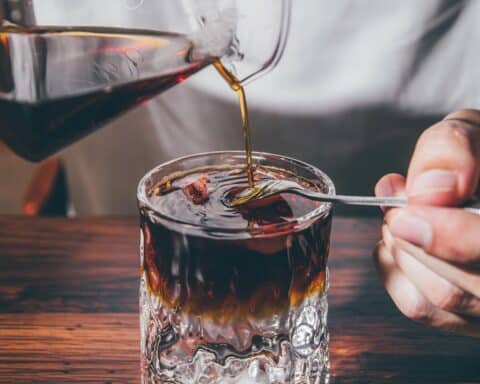Coffee is more than a morning ritual; it is an art form that involves intricate processes and a diverse variety of beans, each influencing the cup’s flavor, aroma, and body. Understanding the journey from bean to brew involves exploring different processing methods that highlight the unique characteristics of each coffee variety. Methods like washed, natural, and honey processing can impact a coffee’s sweetness, acidity, and depth, shaping a distinctive sensory experience.

To appreciate the nuances of flavor, one must consider the diversity of coffee beans sourced from around the globe. Regions like Ethiopia, Colombia, and Indonesia are known for their unique profiles, crafted by climate, soil, and altitude. These factors contribute to the coffee’s complexity, providing a rich palette of tastes and aromas waiting to be explored by enthusiasts.
Brewing methods further enhance this complexity, with techniques such as espresso, pour-over, and French press offering varied expressions of the same beans. Each method requires precision and attention to detail, transforming green beans, which are roasted (https://voltagecoffee.com/brewing-coffee-101/), into a cup that can range from bold and intense to smooth and nuanced. By embracing both the science and the artistry involved, coffee lovers can truly savor the journey from bean to brew.
Origins and Types of Coffee Beans

Coffee beans are not only defined by their species but also by their region of origin, which influences their distinct flavors and aromas. Understanding the nuances between the popular Arabica and Robusta beans, as well as the variations in single-origin and blended coffees, provides valuable insights into how coffee characteristics develop.
Geographical Influence on Flavor Profiles
The region where coffee is grown greatly affects its flavor profile. Factors such as soil composition, altitude, and climate contribute uniquely to the taste of the beans. For instance, Colombian coffee is renowned for its mild but rich taste, often displaying a balanced acidity.
African beans often present bright, fruity notes, while beans from Indonesia might have a more earthy and herbal profile. These geographical factors make each coffee bean unique, showcasing a wide array of flavors that cater to diverse palates.
Arabica and Robusta: Characterizing the Bean
Two primary species dominate the market: Arabica and Robusta beans. Arabica beans are considered superior, accounting for about 60% of the world’s coffee production. They are known for their sweet, soft taste and higher acidity. The complexity of Arabica makes it ideal for specialty coffee.
Conversely, Robusta beans are more bitter, with a stronger, harsher taste. They boast twice the caffeine content of Arabica, contributing to their robust flavor. The hardy nature of Robusta allows it to thrive in lower altitudes, making it a staple in many blends.
Exploring Single Origin and Coffee Blends
Single-origin coffees come from a specific region or country, offering drinkers the chance to experience the distinct flavor profiles of a particular area. These coffees are popular among connoisseurs who appreciate the uniqueness of flavors inherent to their origin.
Blends, on the other hand, combine beans from different regions to create a balanced flavor profile. This approach can harmonize acidity, sweetness, and body, delivering a consistent taste experience. Both single origin and blended coffees hold significant places in the world of coffee, catering to diverse preferences.
Coffee Roasting: From Green to Brown

Coffee roasting transforms raw green coffee beans into aromatic, flavorful products, affecting factors like flavor, sweetness, and oil distribution. This process is crucial for both Arabica and Robusta beans, with precise temperature control determining the outcome.
Understanding Roasting Levels
Different roasting levels influence the flavor profile significantly. Light roast beans maintain a higher acidity and a fruity flavor, with temperatures reaching around 180-205°C (356-401°F). Medium roast balances acidity and sweetness, developing richer flavors at 210-220°C (410-428°F). Dark roast provides a bolder taste with chocolatey, bitter notes, as beans are roasted to 240°C (464°F) and beyond. These levels affect not only taste but also the color and oiliness of the coffee grounds, offering a range of choices for discerning palates.
The Chemistry of Roasting
The chemistry of coffee roasting involves complex reactions within the bean. As temperature rises, sugars caramelize, creating sweetness, and the Maillard reaction occurs, contributing to flavor complexity and color. The oils in the beans migrate to the surface, adding to the coffee’s aroma. Additionally, minerals in the beans participate in these changes, enhancing the overall flavor profile. This chemical transformation is essential for unlocking the distinctive characteristics associated with both Arabica and Robusta beans.
Achieving Consistent Roast Quality
Consistency in roasting is key to ensuring desired flavor profiles. Roasters must carefully monitor the temperature, time, and airflow to produce uniform results. Frequent sampling and tasting help maintain quality without compromising the distinct flavors of Arabica and Robusta varieties. High-quality roasting equipment and meticulous control over each batch are vital. A detailed record of past roasts allows for continuous refinement, ensuring the coffee meets the expected standards each time it’s brewed.
Brewing Methods and Extraction

The art of brewing coffee involves careful consideration of factors such as the coffee-to-water ratio and brewing time, which play essential roles in the flavor and quality of the final cup. Various techniques, from the delicate balance needed for espresso to alternative methods like the French press, highlight the versatility of coffee preparation.
Optimizing the Coffee Ratio and Brewing Time
The coffee-to-water ratio significantly impacts the taste and strength of brewed coffee. Common ratios range from 1:15 to 1:18 parts of coffee to water. Achieving balance is crucial for extracting optimal flavors. Too much coffee can lead to bitterness, while too little results in a weak brew.
Equally important is brewing time. A standard drip coffee takes approximately 4-6 minutes. Lengthening this can cause over-extraction, while shortening results in under-extraction. Understanding these dynamics helps in achieving the perfect coffee.
Espresso Techniques and the Importance of Tamp and Crema
Espresso is a concentrated coffee brewed using finely ground beans and high pressure. An espresso machine requires specific skills, especially in tamping. The tamp compresses coffee grounds in the portafilter for even water distribution. Too much or too little pressure can affect the flavor profile.
Crema, a golden layer on top of an espresso shot, is an indicator of quality. Achieving this foam depends on the freshness of the beans and the extraction method. The presence of a rich crema enhances the overall espresso experience.
Alternative Brewing: From French Press to Cold Brew
The French press, known for its simplicity, allows the user to control variables like the coarseness of grind and steeping time. This brewing method results in a rich, full-bodied coffee. Steep coffee grounds for about 4 minutes before pressing to separate the grounds.
Cold brew, on the other hand, requires a longer extraction time using cold water. This method, taking about 12-24 hours, results in a smoother, less acidic flavor. The versatility of these alternative techniques showcases the diversity in preparing coffee tailored to individual preferences.
Equipment and Tools for the Perfect Cup

Achieving the perfect cup of coffee involves attention to detail, from equipment selection to maintenance. The key tools include a high-quality coffee grinder for precise grinding, using water with the right mineral content, and keeping all equipment well-maintained. Each of these aspects significantly influences the flavor and quality of the brew.
Selecting a Quality Coffee Grinder
A high-quality coffee grinder is essential for unlocking the full potential of coffee beans. Burr grinders, in particular, offer precise and consistent grind sizes, which is crucial for both espresso and other brewing methods. When selecting a grinder, consider factors like grind settings and the materials used in construction, as these impact durability and performance.
Consistent grinding helps balance extraction by ensuring uniformity. This uniformity is especially important when creating espresso as it requires precise measurements. A good grinder can accommodate various brewing methods, from French Press to pour-over. Taking time to choose the right grinder pays dividends in flavor quality.
Importance of Water Quality in Coffee Brewing
The water used in coffee brewing significantly impacts the extraction process and flavor profile of the brew. The mineral content of water contributes to how flavors are extracted from the coffee grounds. Using quality water with balanced minerals can enhance the taste of the final cup.
Water that’s too hard or too soft can lead to undesirable flavors. The ideal water temperature for brewing is between 195°F and 205°F, ensuring optimal extraction without bitter notes. Ensuring that the water is filtered and has the right pH balance boosts the superiority of a perfect cup of coffee.
Maintenance and Calibration of Coffee Equipment
Maintaining and calibrating coffee equipment is crucial for consistent quality. Regular cleaning prevents the build-up of coffee oils and residues, which can taint flavors. For machines like espresso machines, periodic descaling is vital to remove mineral build-up from water deposits.
Calibration involves adjusting equipment, like grinders, to maintain consistency in grind size as blades wear down over time. Well-maintained equipment lasts longer and produces better-tasting coffee, no matter the brewing methods used. Investing time in regular maintenance ensures the delight of an impeccable brew with every cup.
Coffee Culture and Consumption

Coffee culture encompasses the various ways coffee is consumed and appreciated around the world. From educational approaches to brewing this beloved beverage to the experience of enjoying a cup in a coffee shop, the diversity in coffee culture highlights its global significance. Sustainability also plays a critical role in consumption practices today.
The Rise of Coffee Academies and Education
Coffee academies have become a cornerstone for those eager to understand and appreciate coffee on a deeper level. These institutions offer courses that cover the diversity of beans, brewing techniques, and flavor profiles. Such educational opportunities provide enthusiasts with insights into specialty coffee, shaping their palates and enhancing their appreciation.
Knowledge dissemination is crucial. Enthusiasts learn about the best coffee practices, which equips them to recognize quality and develop their own preferences. Coffee academies also contribute to a shared community culture where enthusiasts can exchange ideas and experiences, creating a vibrant network of informed consumers and professionals. With more people now educated in these nuances, coffee culture continues to evolve and expand.
Coffee Shops and Consumer Experience
Coffee shops have evolved into social hubs, offering more than just beverages. The atmosphere and consumer experience are increasingly significant in determining the best coffee shops. Features such as ambiance, customer service, and the variety of coffee flavors offered impact consumer satisfaction.
Some shops focus on providing a unique experience with specialty coffee options crafted to match diverse tastes. Patrons frequently seek establishments that cater to their preferences, whether through innovative brewing methods or themed interiors. This evolution of coffee shops reflects a broader trend where consumer experience is as cherished as the coffee itself, further enriching coffee culture.
Sustainability and Ethical Coffee Sourcing
Sustainability remains a prominent topic in coffee culture. Ethical sourcing practices ensure producers receive fair compensation and promote environmentally-friendly cultivation methods. These initiatives aim to address challenges like deforestation and promote social equity within coffee-producing communities.
Consumers increasingly demand transparency in how their coffee is sourced. This shift encourages coffee shops and brands to pursue sustainable practices, such as eco-friendly packaging or supporting organic farming. Ethical coffee sourcing is more than a trend; it’s part of a commitment to a sustainable future, making it an essential aspect of modern coffee culture and consumption.







